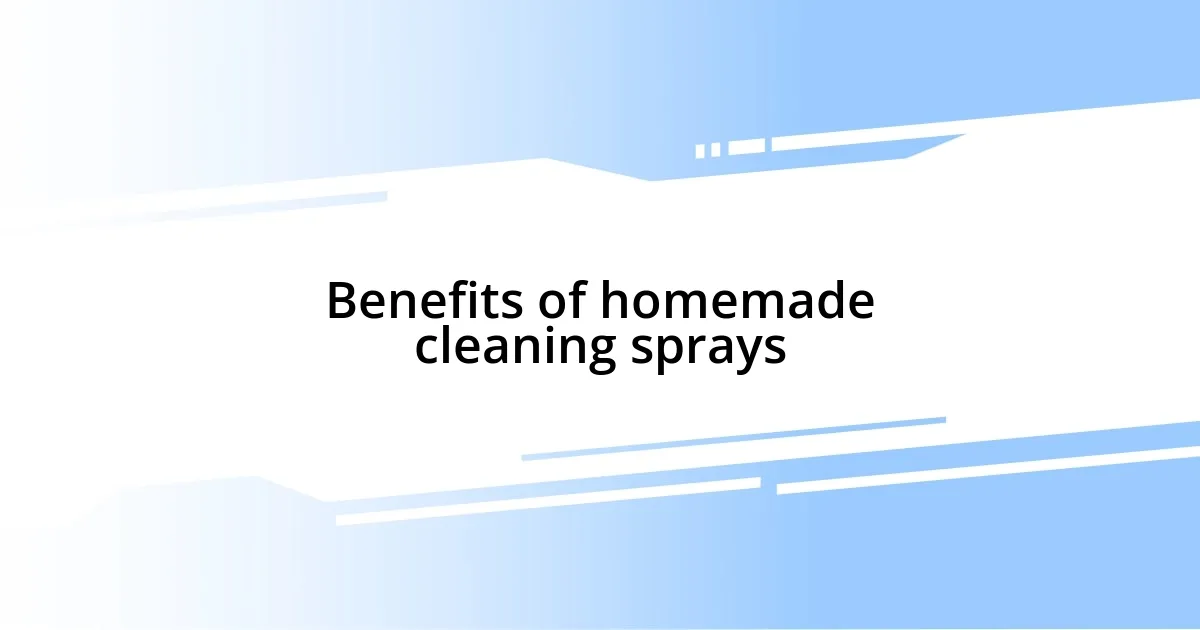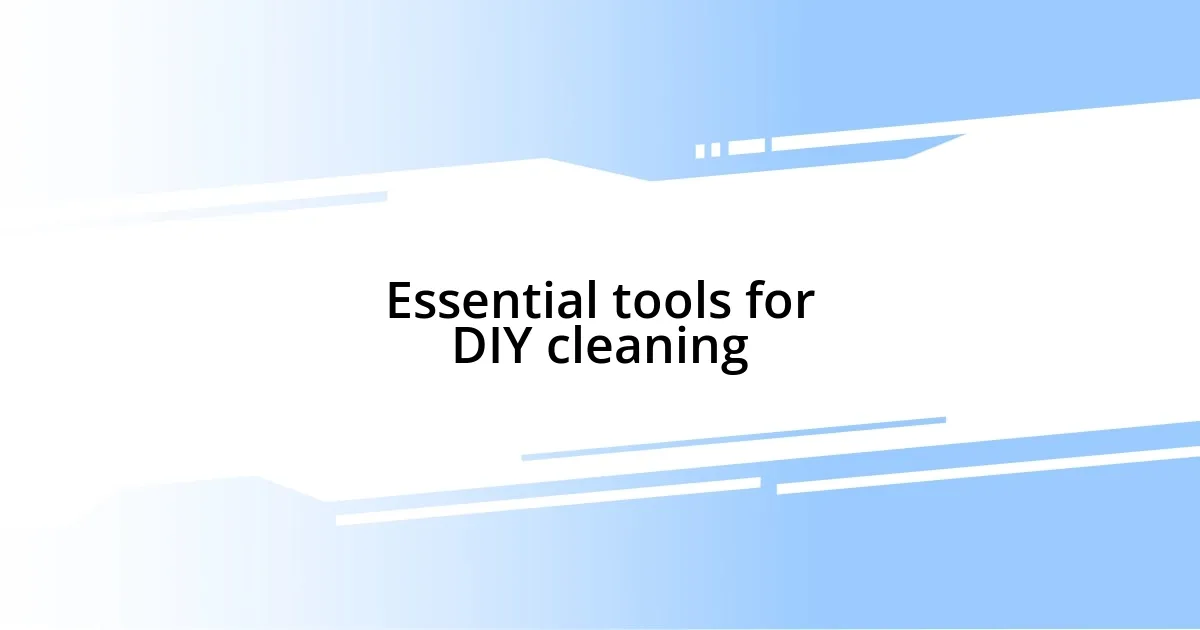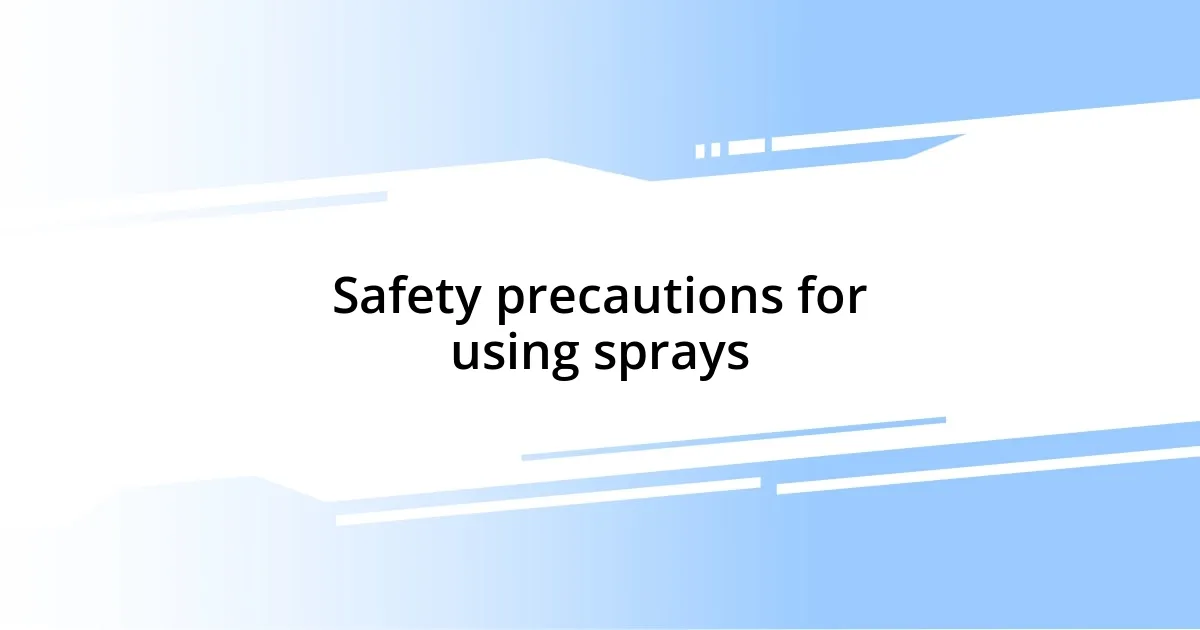Key takeaways:
- Choosing ingredients for homemade cleaning sprays should focus on effectiveness, scent, and safety, considering potential allergies in the household.
- Homemade cleaning sprays offer benefits like cost savings, customizable scents, eco-friendliness, safety, and versatility.
- Essential tools for DIY cleaning include a quality spray bottle, funnel, measuring cups, microfiber cloths, and a spray mop for efficiency.
- Safety precautions are crucial; avoid mixing harmful ingredients, wear protective gear, and ensure proper ventilation when using sprays.

Choosing the right ingredients
When choosing the right ingredients for your cleaning sprays, it’s essential to consider both effectiveness and safety. I remember the first time I made a spray with vinegar; the pungent smell was overwhelming but it worked wonders on my kitchen counters. That experience made me realize how crucial it is to balance the potency of the ingredients with their scent and safety for the environment and my family.
I often opt for essential oils not just for their delightful fragrances, but also for their natural antibacterial properties. Have you ever mixed tea tree oil with lemon? It’s not just refreshing; it also creates a powerful cleaner that leaves everything sparkling. This blend showcases how simple ingredients can pack a punch while making your home smell amazing.
Don’t forget to check for allergies or sensitivities within your household. Once, I used a spray with lavender oil, only to find out my friend visiting had a strong aversion to it. It made me think about how thoughtful we have to be when selecting our ingredients. Tailoring your cleaning sprays to your specific needs not only makes your cleaning more enjoyable but also ensures a safe environment for everyone.

Benefits of homemade cleaning sprays
Homemade cleaning sprays bring a refreshing sense of control over what goes into my cleaning routine. I’ve always found it rewarding to know precisely what ingredients I’m using, unlike commercial cleaners that can be bogged down with unknown chemicals. I remember feeling empowered the first time I used my homemade recipe to clean my bathroom; the satisfaction of seeing sparkling tiles without the harsh chemical smell was unbeatable.
Here are some key benefits of making your own cleaning sprays:
- Cost-effective: Creating cleaning sprays at home saves money, as basic ingredients like vinegar and baking soda are affordable and multitask as other household cleaners.
- Customizable scents: You can choose your favorite essential oils, making each cleaning session enjoyable and aromatic.
- Eco-friendly: My choices reflect my commitment to the environment; homemade sprays reduce plastic waste and avoid harmful chemicals that could pollute our planet.
- Safety: Using non-toxic ingredients gives me peace of mind, especially when I consider pets and small children who might come into contact with my cleaning surfaces.
- Versatility: I can easily adjust my blends for different surfaces or specific cleaning challenges, so my arsenal is tailored to my home.

Essential tools for DIY cleaning
When diving into DIY cleaning sprays, having the right tools on hand makes all the difference. Personally, I can’t imagine my cleaning routine without a quality spray bottle. Investing in a good, reusable bottle not only helps me stay organized but also reduces waste. After trying a few flimsy bottles, I settled on a sturdy glass one that’s both elegant and effective. It’s wonderful to feel confident that my materials won’t leak all over my cabinets!
Another essential tool is a funnel, especially when transferring liquids. The first time I tried pouring my homemade cleaner into a bottle without one, I ended up with more on my counter than in the bottle! The simple act of using a funnel saved me both time and frustration. Speaking of which, consider using measuring cups or spoons to ensure precise ingredient ratios for effectiveness. Accurate measurements can truly elevate the quality of your sprays.
Finally, a spray mop for larger areas is a game-changer. When I first started using mine, I found it transformed my cleaning routine. Now, not only am I able to distribute my homemade cleaner evenly on the floor, but I also enjoy the process itself. I often get lost in the rhythm of cleaning, and the right tools enhance that concentrated state. With these essentials, I feel ready to tackle any cleaning challenge that comes my way.
| Tool | Purpose |
|---|---|
| Spray Bottle | For storing and applying cleaning solutions |
| Funnel | For transferring liquids without spills |
| Measuring Cups/Spoons | For accurate ingredient measurements |
| Microfiber Cloths | For effective wiping and dusting surfaces |
| Spray Mop | For distributing cleaner on floors easily |

Variations for specific cleaning needs
When it comes to tackling specific cleaning needs, I’ve discovered several variations that have truly made a difference in my home. For instance, when I’m facing stubborn grease in my kitchen, I whip up a spray that combines vinegar, baking soda, and a few drops of dish soap. This blend not only cuts through the grime but also leaves a fresh scent that transforms my cleaning experience. Doesn’t it feel amazing to triumph over tough stains with something so simple?
For bathroom cleaning, I’ve found that a mix of equal parts vinegar and water, with added tea tree oil, works wonders. Not only does it disinfect surfaces, but the natural antifungal properties of tea tree oil add another layer of protection. I remember the first time I used it; the smell instantly rejuvenated my space. My bathroom felt less like a chore zone and more like a calming retreat. Who wouldn’t want that?
When it’s time to freshen up my fabric upholstery, I’ve created a gentle spray using water, white vinegar, and a few drops of lavender essential oil. The lavender not only brings a calming aroma but also acts as a natural deodorizer. I still smile thinking about the time my guests commented on how inviting my living room felt thanks to that simple mix. Have you ever noticed how a pleasant scent can change the whole vibe of a room?

Storage tips for your sprays
When it comes to storing my homemade cleaning sprays, I always opt for a cool, dark place. Direct sunlight can break down essential oils and other ingredients, diminishing their effectiveness. I learned this the hard way after a particularly hot summer left my once-vibrant lemon-scented cleaner smelling more like a distant memory than a fresh boost for my kitchen.
I also find that labeling my bottles is crucial for avoiding mix-ups. Each label serves as a visual reminder of the purpose of each spray—be it for windows, kitchen counters, or bathroom surfaces. It’s not just about neatness; it’s about efficiency during my cleaning routine. A misplaced bottle can lead to minor disasters, like accidentally using a bathroom cleaner on my kitchen table!
In terms of the materials I choose for my bottles, I have a soft spot for glass over plastic. It’s a bit heavier, sure, but it feels more robust and less likely to leach chemicals into my cleaners. Plus, the glass captures that sense of craftsmanship that makes my cleaning experience feel more intentional. Have you ever noticed how using a beautiful, well-made container can enhance the overall experience? It turns the chore of cleaning into a ritual I actually look forward to!

Safety precautions for using sprays
When using cleaning sprays, safety should always be at the forefront of your mind. I’ve learned the hard way that mixing certain ingredients can lead to unpleasant reactions. For example, combining vinegar and bleach creates toxic fumes that can be incredibly harmful. Have you ever accidentally created a noxious cloud while trying to tidy up? It’s an experience you won’t soon forget.
Wearing protective gear is crucial whenever I’m using my homemade cleaners. I make it a habit to put on gloves, especially when working with acidic solutions. One time, I neglected this step and ended up with a burning sensation on my hands from a vinegar spray. It was a painful reminder that even natural ingredients can be harsh. I always remind myself that a little precaution goes a long way.
Proper ventilation is another key aspect I consider seriously. Whenever I start cleaning, I open windows to let fresh air circulate. I once closed myself off in a room while disinfecting, and the overpowering scent made me feel dizzy. It’s those moments that reinforce how important it is to be mindful of my environment while spraying. What’s your go-to strategy for ensuring a safe cleaning session?














